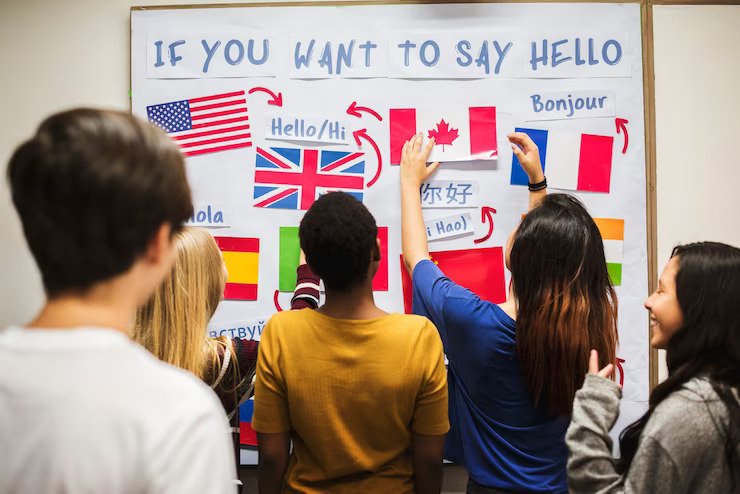Enhancing Cross-Cultural Work Connections with Foreign Language Skills
by Ankita Tripathy Business Development 30 August 2023

In today’s global marketplace, cross-cultural communication is crucial for business interactions.
With companies expanding their operations internationally, effective communication between employees, clients, and partners from diverse cultural backgrounds has become crucial.
This article delves into the significance of foreign language skills in cross-cultural communication at work and explores how multilingualism can bridge gaps and foster better relationships in a multicultural workplace.
Understanding Cross-Cultural Communication
Imagine working in a team with people from various countries and backgrounds. It’s like a mini United Nations! Cross-cultural communication is all about being able to understand and connect with these diverse teammates. You learn to respect their customs, values, and different ways of talking.
Language is like a magic key that opens doors to new friendships and opportunities. When you speak someone’s language, it’s like saying, “Hey, I want to know you better!” But when language barriers get in the way, misunderstandings can happen, and that’s not cool.
Developing Foreign Language Skills

⚪
So, you might be wondering, “How can I learn a new language?” Well, there are plenty of options! You can take classes, use language apps, or even travel to a foreign country for an immersive experience. It’s like going on an exciting language adventure!
1. Language Classes:
Enrolling in language classes, whether in-person or online, is a structured and traditional approach to learning a new language. Many educational institutions and language centers offer courses taught by experienced instructors who guide students through grammar, vocabulary, and conversational practice.
2. Language Apps:
In the digital age, language learning apps have gained popularity. These apps provide interactive lessons, quizzes, and exercises to help learners practice reading, writing, listening, and speaking skills.
3. Immersion through Travel:
For a more immersive experience, nothing beats traveling to a foreign country where the language is spoken. Being surrounded by native speakers and immersing oneself in the culture helps accelerate language learning and provides practical, real-life usage opportunities.
4. Language Exchange Partners:
Connecting with language exchange partners can be an effective way to practice speaking and listening skills. You can find language exchange groups or platforms where you can meet native speakers of your target language who want to learn your native language in return.
5. Online Language Tutor:
Hiring an online language tutors a convenient and personalized way to learn a new language. Tutors can tailor lessons according to your proficiency level and specific goals, providing focused attention and feedback.
For example, in Sydney, there are professionals who find themselves in workplaces where Mandarin Chinese is commonly spoken among colleagues. To enhance their communication within this linguistic environment, many have turned to the assistance of a qualified Mandarin Chinese tutor in Sydney. Through tailored classes and comprehensive courses, individuals are equipped with the necessary language skills to engage seamlessly with their colleagues.
The option of hiring an online language tutor offers a personalized and convenient way to learn. These tutors adeptly adjust their teaching techniques to match proficiency levels and specific goals, ensuring focused learning and valuable progress. As a result, those who once faced language barriers can now confidently converse and connect with their colleagues in Mandarin Chinese.
6. Language Meetup Groups:
Many cities have language meetup groups where language enthusiasts gather to practice speaking in different languages. These casual gatherings offer a supportive environment to interact with native speakers and language learners alike.
7. Language Immersion Programs:
Some language schools and cultural organizations offer immersive programs where learners live with host families or participate in language-focused activities throughout the day, creating an intense language-learning experience.
8. Multimedia Resources:
Language learning doesn’t have to be limited to textbooks. There are numerous multimedia resources available, such as language podcasts, YouTube channels, and online videos that expose learners to authentic conversations and cultural nuances.
9. Language Books and Reading Material:
Reading books, articles, and newspapers in the target language can expand vocabulary and improve language comprehension. Starting with simpler texts and gradually progressing to more complex ones can be beneficial.
10. Language Challenges and Games:
Engaging in language challenges and games can make learning enjoyable. For example, setting a goal to learn a certain number of new words each day or playing language-related board games can add an element of fun to the learning process.
Remember, the key to successful language learning is consistency and practice. Whether you choose one method or combine several, the journey to mastering a foreign language can be rewarding and open up a world of opportunities for cross-cultural connections.
The Connection Between Language and Culture
Language and culture go hand in hand! The way people talk often reflects their beliefs, customs, and values, providing fascinating insights into their unique worldviews and societal norms. When you understand their language, you unlock the door to a rich tapestry of traditions, historical perspectives, and ways of life that shape their identity.
Language serves as a powerful vehicle for transmitting cultural heritage across generations. Through words, idioms, and expressions, communities pass down stories, folklore, and collective wisdom that encapsulate their history and experiences. For instance, a simple greeting in one culture may carry profound meanings of respect, hospitality, or familial ties, while in another culture, it may signify camaraderie, formality, or even spiritual connections.
Moreover, language plays a significant role in shaping interpersonal dynamics within a community. In some cultures, the use of specific honorifics or pronouns reflects hierarchical structures and levels of respect, emphasizing the importance of social harmony and etiquette. In contrast, other cultures may adopt more egalitarian language forms, emphasizing inclusivity and equality among individuals.
Beyond spoken language, nonverbal communication also conveys cultural nuances. Gestures, body language, and facial expressions can differ greatly across cultures and carry implicit meanings that may not be apparent to outsiders. Being attuned to these subtleties can prevent misunderstandings and promote effective cross-cultural communication.
Language even influences artistic expressions, such as literature, poetry, music, and art, which often draw inspiration from cultural themes, historical events, and societal values. Translating works of art from one language to another requires careful consideration of cultural contexts to preserve the essence and intended message of the original creation.
Understanding the connection between language and culture fosters empathy and respect for diverse perspectives, paving the way for meaningful intercultural interactions. It enables individuals to engage more authentically with people from different backgrounds, fostering mutual understanding and cooperation.
Overcoming Language Barriers in Virtual Workspaces
Enlightened employers recognize that a content and united team is a highly productive one. They actively promote language learning, embrace diversity, and cultivate an inclusive work environment where every individual is esteemed and appreciated.
- Encouraging Language Learning: Forward-thinking employers understand the value of language skills in enhancing communication across diverse teams and with clients from various backgrounds. They may offer language learning resources, support language classes, or provide access to language apps and tools, empowering employees to bridge language gaps and connect on a deeper level.
- Celebrating Diversity: Embracing diversity isn’t just a buzzword for these employers; it’s a core belief that enriches the workplace. They actively celebrate different cultural festivals, holidays, and traditions, acknowledging the uniqueness of each team member’s background and fostering an atmosphere of mutual respect.
- Creating an Inclusive Environment: Inclusive workplaces are those where employees feel they belong, regardless of their cultural background or identity. These employers proactively promote a culture of openness, actively listening to employees’ ideas, and ensuring that everyone has a voice in decision-making processes. They actively work against discrimination and bias, ensuring fair treatment for all.
- Training in Cross-Cultural Communication: To facilitate effective communication among team members with diverse cultural backgrounds, these employers invest in cross-cultural communication training. Such training equips employees with the knowledge and skills to navigate potential cultural barriers, promote understanding, and avoid misinterpretations.
- Promoting Employee Resource Groups: Employee resource groups (ERGs) are communities within the workplace that bring together individuals with shared characteristics or experiences. These employers encourage the formation of ERGs based on culture, ethnicity, or language, providing a platform for employees to support one another, share insights, and foster cross-cultural understanding.
- Organizing Cultural Exchange Programs: These employers organize cultural exchange programs that encourage employees to learn about each other’s cultures and experiences. They may host multicultural events, workshops, or lunch sessions, allowing team members to share aspects of their cultural heritage and develop empathy for one another.
- Recognizing and Rewarding Inclusivity: Inclusivity isn’t just a goal for these employers; it’s a value they actively reinforce. They recognize and reward employees who actively contribute to fostering an inclusive work environment. This acknowledgment can take the form of appreciation awards, bonuses, or other incentives.
- Encouraging Collaboration and Team-Building: To facilitate cross-cultural connections, these employers promote teamwork and collaboration among employees from different backgrounds. They design team-building activities that encourage collaboration, communication, and camaraderie, breaking down barriers and strengthening interpersonal relationships.
Proactive employers understand that fostering cross-cultural communication is not only essential for a harmonious work environment but also critical for driving innovation and success in a globalized world. By prioritizing language learning, celebrating diversity, and nurturing inclusivity, they create a workplace where every team member can thrive, bringing their unique perspectives and strengths to the table.
Read Also:







































































































